 |
|||||||||||||||||||||||||||||||||||||||||||
|
“the trees don't die, they just pretend,
go out in style, and return in style: a new style.”
|
|||||||||||||||||||||||||||||||||||||||||||
|
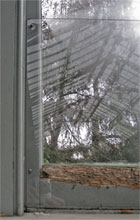 It won’t happen today, but sometimes when the temperatures get into the low 60’s the doors of the camellia house are opened. It’s then that birds and the occasional squirrel get trapped inside. Last winter a squirrel that had been shut inside when the doors closed tried to get out by gnawing on the lower sashes of two of the wooden windows. The damage still hasn’t been repaired, but the keepers of this botanical garden have come up with an ingenious solution to prevent other wayward squirrels from getting at the wood. They’ve installed a piece clear acrylic over the lower part of each window. So now those inside squirrels will be able to see how to escape, but when they try, they’ll bump into a tough sheet of plastic. Problem solved? I doubt it. I’m betting on the squirrels. It won’t happen today, but sometimes when the temperatures get into the low 60’s the doors of the camellia house are opened. It’s then that birds and the occasional squirrel get trapped inside. Last winter a squirrel that had been shut inside when the doors closed tried to get out by gnawing on the lower sashes of two of the wooden windows. The damage still hasn’t been repaired, but the keepers of this botanical garden have come up with an ingenious solution to prevent other wayward squirrels from getting at the wood. They’ve installed a piece clear acrylic over the lower part of each window. So now those inside squirrels will be able to see how to escape, but when they try, they’ll bump into a tough sheet of plastic. Problem solved? I doubt it. I’m betting on the squirrels.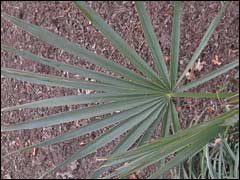 Last fall there were three varieties of subtropical palms growing outside in this botanical garden: a Needle Palm (Rhapidophyllum hystrix), a Chinese Windmill Palm (Trachycarpus fortunei); and a Dwarf Palmetto (Sabal minor). None were expected to grow into some luxuriant South Seas dream. -- even at maturity, they would still be just clumps. Still, they were all touted as being hardy tropicals -- able to come through our Zone 6 winters. Out of three palms, one is left – the Dwarf Palmetto. It hasn’t grown much since it was planted last year, but it did make it through one winter and looks very healthy as it goes into its second. Last fall there were three varieties of subtropical palms growing outside in this botanical garden: a Needle Palm (Rhapidophyllum hystrix), a Chinese Windmill Palm (Trachycarpus fortunei); and a Dwarf Palmetto (Sabal minor). None were expected to grow into some luxuriant South Seas dream. -- even at maturity, they would still be just clumps. Still, they were all touted as being hardy tropicals -- able to come through our Zone 6 winters. Out of three palms, one is left – the Dwarf Palmetto. It hasn’t grown much since it was planted last year, but it did make it through one winter and looks very healthy as it goes into its second.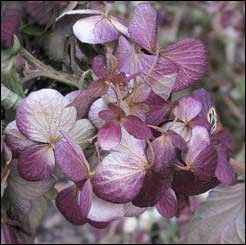 I never cut the spent blossoms from any of the hydrangeas planted around my house. The old heads add a little winter color and texture, but mostly I keep them on because they remind me of their better times. The petals of the hydrangeas I have at home and the ones I’ve seen at this botanical garden, always turn tan or some shade between pink and rose. This morning I saw a spent hydrangea head that turned violet and white. Each cluster dangling at the end of a stem looked like a tussy mussy of violets. This hydrangea was growing along the walkway in the German Garden. The label named it Hydrangea macrophylla 'Alpenglühen' (Glowing Embers). I didn’t notice when it bloomed, but the pictures in garden catalogs describe it as having “blooms of unusual deep rose pink, almost crimson--8" across.” I never cut the spent blossoms from any of the hydrangeas planted around my house. The old heads add a little winter color and texture, but mostly I keep them on because they remind me of their better times. The petals of the hydrangeas I have at home and the ones I’ve seen at this botanical garden, always turn tan or some shade between pink and rose. This morning I saw a spent hydrangea head that turned violet and white. Each cluster dangling at the end of a stem looked like a tussy mussy of violets. This hydrangea was growing along the walkway in the German Garden. The label named it Hydrangea macrophylla 'Alpenglühen' (Glowing Embers). I didn’t notice when it bloomed, but the pictures in garden catalogs describe it as having “blooms of unusual deep rose pink, almost crimson--8" across.”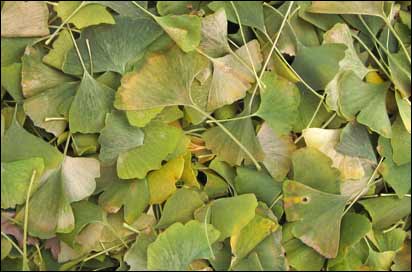 The leaves on the giant gingko trees in this botanical garden usually end their season by making a slow switch from green to a yellow that’s so bright it looks orange on sunny days. This fall the color change was unusually slow. Many of the leaves were just in midst of turning yellow when the cold weather set in. Within days, all of the leaves dropped. This morning the ground was covered with leaves that will never finish changing. 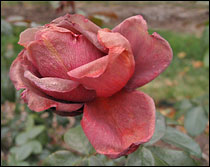 Like migrating birds the photographers have abandoned the Rose Garden. It’s as though taking a picture of a rose in anything less than its dewy just opened state is pornographic. The quick freezes of the last few weeks have sapped the color from their petals, but the beauty of roses' shape and texture remains. In a few more weeks though, even these remnants will be gone, the canes will be trimmed, and mounds of mulch will be put in place to keep the bushes safe until spring. Like migrating birds the photographers have abandoned the Rose Garden. It’s as though taking a picture of a rose in anything less than its dewy just opened state is pornographic. The quick freezes of the last few weeks have sapped the color from their petals, but the beauty of roses' shape and texture remains. In a few more weeks though, even these remnants will be gone, the canes will be trimmed, and mounds of mulch will be put in place to keep the bushes safe until spring.Just this week a new camellia was planted in the English Woodland Garden. A sign nearby named it ‘Korean Fire.’ Unlike other cold- hardy camellias that are crosses with some cold resilient specie have names like ‘Winter’ or ‘April’, ‘Korean Fire’ is a Camellia japonica. That’s a variety that I thought could only survive under glass in this zone 6 climate. Turns out there’s a story behind this small shrub. It starts with Barry Yinger, a plant hunter who now owns Asiatica, a mail order nursery outside of Harrisburg, Pennsylvania, that specializes in hard-to-find Asian plants. Yinger has been travelling to Asia for more than thirty years to study, work, and find unusual plants. Because he can speak and read Japanese, Korean, and Chinese, he is able to go to places and learn things that others might miss. He says that he first learned about hardy varieties of Camellia japonica in 1981 when he was working at a botanical garden in Korea. While there he read an article written in the early 1900’s about a colony of hardy Camellia japonicas growing on a hilly island off the west coast of Korea. That island, Sochong Island, is now a military outpost. While controlled by South Korea, Sochong Island is within sight of the North Korean mainland. (For a closer look at the island, search for Socheong-do on Google Earth) Yinger wanted to see if the colonies of japonicas still existed on the island. So with the promise of a few bottles of good scotch, he managed to get himself on board a military supply launch headed to Sochong. There on a windswept hillside in the middle of winter he found the colony described in the article. Some of the camellia trees were twenty feet tall with trunks that were ten inches across. Under the trees, the ground was littered with hundreds of seeds. It was from these seeds and the seeds collected from a subsequent trip that Yinger found the exceptionally hardy Camellia japonica that he named ‘Korean Fire.’ 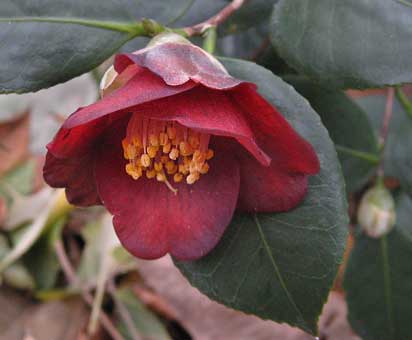 If it survives here in this botanical garden, ‘Korean Fire’ will ordinarily bloom in early spring. I think the blooms I saw this morning just came with the new plant. Their bright red flowers are from two to three inches across and are filled with clusters of yellow stamens. ‘Korean Fire’ is supposed to tolerate subzero temperatures, but we’ll have to see how a Midwest winter treats this newcomer. 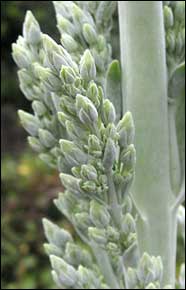 Last February the trees planted in the containers in this botanical garden’s atrium were surrounded by Kalanchoes named ‘Flapjacks.’ Then each plant was about the size of a softball. They caught my attention because of their meaty-looking leaves that were arranged like windmill blades around a central core. Like the other plantings in the atrium, they came and then were gone within a month. Now they’re back again. And how they’ve grown. The ‘Flapjacks,’ all grown up now have been replanted in the California section of the temperate gardens glasshouse. I’ve been waiting for weeks to see the buds that line their four-foot flower stocks open. I was going to wait until they bloomed to take their picture, but they wait more patiently than I do. Last February the trees planted in the containers in this botanical garden’s atrium were surrounded by Kalanchoes named ‘Flapjacks.’ Then each plant was about the size of a softball. They caught my attention because of their meaty-looking leaves that were arranged like windmill blades around a central core. Like the other plantings in the atrium, they came and then were gone within a month. Now they’re back again. And how they’ve grown. The ‘Flapjacks,’ all grown up now have been replanted in the California section of the temperate gardens glasshouse. I’ve been waiting for weeks to see the buds that line their four-foot flower stocks open. I was going to wait until they bloomed to take their picture, but they wait more patiently than I do.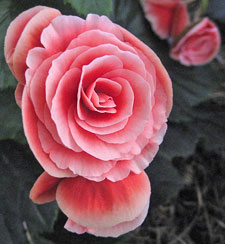 Large stone planters filled with small trees are scattered in the atrium that opens to the gardens outside. The trees, set in the center of the planters, never change. The plantings around them do though – almost weekly. This week the ground surrounding the trees is filled with begonias at the peak of their blooming. With their subtle colorings and shape, these begonias would feel right at home in the camellia house or the rose garden. The sign stuck in the planters says the begonias are named ‘Borias.’ I would bet that the limited planting done here is just a preview of a larger rollout planned for the holiday shows just ahead. Large stone planters filled with small trees are scattered in the atrium that opens to the gardens outside. The trees, set in the center of the planters, never change. The plantings around them do though – almost weekly. This week the ground surrounding the trees is filled with begonias at the peak of their blooming. With their subtle colorings and shape, these begonias would feel right at home in the camellia house or the rose garden. The sign stuck in the planters says the begonias are named ‘Borias.’ I would bet that the limited planting done here is just a preview of a larger rollout planned for the holiday shows just ahead. In another two weeks the halls inside this botanical garden will be filled with children. The garden’s annual holiday shows open on Thanksgiving weekend. Kids will be here then to watch toy trains meander through miniature landscapes or to sit along side Santa. To forestall accidents, the keepers of the garden have installed acrylic panels along the staircase railings in the atrium. Before today, the railings were a series of four parallel bars with gaps of about a foot and a half between bars. Now those gaps have been closed. The new panels are frosted except for clear spaces that form a pattern of interlocking vines. In another two weeks the halls inside this botanical garden will be filled with children. The garden’s annual holiday shows open on Thanksgiving weekend. Kids will be here then to watch toy trains meander through miniature landscapes or to sit along side Santa. To forestall accidents, the keepers of the garden have installed acrylic panels along the staircase railings in the atrium. Before today, the railings were a series of four parallel bars with gaps of about a foot and a half between bars. Now those gaps have been closed. The new panels are frosted except for clear spaces that form a pattern of interlocking vines.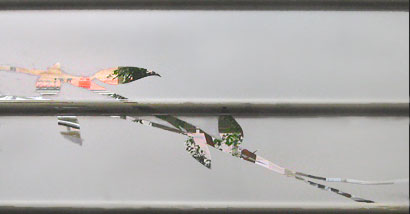 I read a magazine article that described a gardener’s aversion to touching the remains of tender perennials and bulbs that had turned to the consistency of rotting bananas. She said that late fall made her anxious because she was afraid she’d either cut too soon or too late. Too soon and she’d miss the last days of her dahlias, cannas, hostas, and caladiums. Too late and she’d have to deal with beauty gone to oozing flesh. Here in this botanical garden, today’s the day she’d dread. The hostas have lost their backbones and turned to mush. 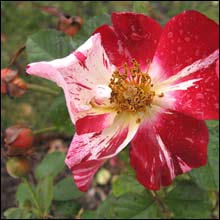 What does a prize winning rose named ‘Fourth of July’ look like in mid-November? Not bad, I’d say. At least this one, last bloom doesn’t. The rest of the climber is loaded with maturing rose hips and the ground around is littered with fallen petals. What does a prize winning rose named ‘Fourth of July’ look like in mid-November? Not bad, I’d say. At least this one, last bloom doesn’t. The rest of the climber is loaded with maturing rose hips and the ground around is littered with fallen petals.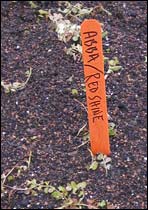 All of the tulips are in. The ground that they’ll completely fill next March and April is bare except for lhese temporary orange markers that let visitors know what’s to come. Most of the sticks name a combo of tulips – usually an early booming one paired with one that blooms in mid-season or a mid-season variety that shares a space with a late-bloomer. Then just in case spring doesn’t cooperate by neatly dividing itself into the seasons the bulb growers describe, the paired bulbs also differ in height by a few inches. Under this stake are ‘Red Shine’ -- a deep-red lily-petaled tulip on 22-inch stems that blooms in mid-season, and ‘Abba’ -- a early blooming, red double tulip on 15-inch stems. All of the tulips are in. The ground that they’ll completely fill next March and April is bare except for lhese temporary orange markers that let visitors know what’s to come. Most of the sticks name a combo of tulips – usually an early booming one paired with one that blooms in mid-season or a mid-season variety that shares a space with a late-bloomer. Then just in case spring doesn’t cooperate by neatly dividing itself into the seasons the bulb growers describe, the paired bulbs also differ in height by a few inches. Under this stake are ‘Red Shine’ -- a deep-red lily-petaled tulip on 22-inch stems that blooms in mid-season, and ‘Abba’ -- a early blooming, red double tulip on 15-inch stems.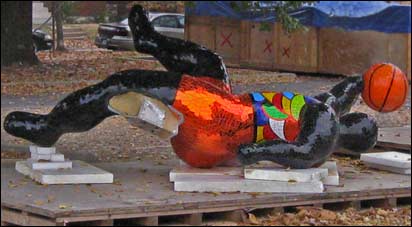 The West parking lot is lined with crates that will soon be filled with artist Niki de Sainte Phalle’s sculptures and then trucked off to their next showing. Her quirky sculptures of real and imagined people and animals have added color, texture, and fun to my visits to the botanical garden since they began appearing on the grounds in mid-April. The exhibit of nearly 40 of her pieces ended on October 31, but with a show of this size, the takedown and packing will likely take several weeks because of the heavy equipment needed to move the pieces – some of which weigh more than a ton. This morning I saw this Niki sculpture of Michael Jordan lying prone on a pallet waiting to lifted into a crate.  Here’s a picture of Michael in action taken a couple of weeks ago against a backdrop of turning trees. Here’s a picture of Michael in action taken a couple of weeks ago against a backdrop of turning trees. Most of the hostas have been cut back or are yellowing and browning. Exceptions are the very tiny-leaved hostas planted in small space between the wall of a building and a brick walkway. There’s enough heat and shelter there to keep varieties such as ‘Bread Crumbs’ and ‘Cookie Crumbs’ going until a hard freeze finally takes them. Among these small late-season survivors, my favorite is a variety named ‘Cameo.’ It’s impossible to tell from the photo, but the plant is only a few inches high and each of the creamy white leaves is no more than two-inches long. Most of the hostas have been cut back or are yellowing and browning. Exceptions are the very tiny-leaved hostas planted in small space between the wall of a building and a brick walkway. There’s enough heat and shelter there to keep varieties such as ‘Bread Crumbs’ and ‘Cookie Crumbs’ going until a hard freeze finally takes them. Among these small late-season survivors, my favorite is a variety named ‘Cameo.’ It’s impossible to tell from the photo, but the plant is only a few inches high and each of the creamy white leaves is no more than two-inches long.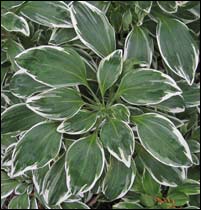 It’s not a variegated hosta, but from a distance it could be mistaken for one. Now that all of the tender bulbs and plants have been cleared from the display beds, this variegated variety of alstroemeria (Peruvian Lily) named ‘Royal Star’ is very prominent. Books say that ‘Royal Star’ won’t survive in this Zone 6 botanical garden, but for now it’s thriving. It’s not a variegated hosta, but from a distance it could be mistaken for one. Now that all of the tender bulbs and plants have been cleared from the display beds, this variegated variety of alstroemeria (Peruvian Lily) named ‘Royal Star’ is very prominent. Books say that ‘Royal Star’ won’t survive in this Zone 6 botanical garden, but for now it’s thriving.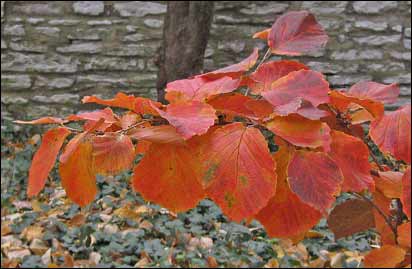 We have a witch hazel named ‘Arnold Promise’ planted in the border along the south side of our house. This week its leaves turned yellow and then shifted to orange before they dropped. Wanting to see what fall does to other witch hazels I made the rounds of the garden’s collection of witch hazels. For past two years this botanical garden has slowly been increasing the number and varieties in its collection of witch hazels. I wanted to see which witch hazel put on the best fall display. My first choice (with none other even a close second) was ‘Diane’ (Hamamelis x intermedia). Unlike most of the other witch hazels that turn to varying shades of yellow, ‘Diane’ is all oranges and brilliant reds. 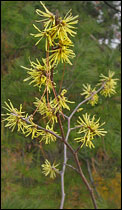 One other thing about witch hazels: As if out of nowhere all of the native witch hazels (Hamamelis virginiana) came into full bloom this week. The trees kindly dropped their leaves before blooming so that we visitors can have an unobstructed view of the flowers. One other thing about witch hazels: As if out of nowhere all of the native witch hazels (Hamamelis virginiana) came into full bloom this week. The trees kindly dropped their leaves before blooming so that we visitors can have an unobstructed view of the flowers.November is the time to look again at the fall blooming hardy camellias planted in the English Woodland Garden. Two of the shrubs planted here have survived two winters: ‘Winter’s Star’ and ‘Winter’s Joy.’ Both were developed by Dr. William Ackerman at the U.S. National Arboretum in Washington after an unseasonably cold winter wiped out most of the Arboretum’s regular collection. This is the third fall that ‘Winter’s Star’ has bloomed. Its flowers look like a shrub rose with petals that shade from reddish pink to a blush. For ‘Winter’s Joy,’ a camellia with peony-like, red-pink flowers, this fall marks its debut. 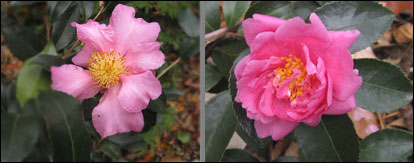  Last week the weather edged out politics as something to be bothered about. The first frost was coming the weather people warned. Temperatures in the mid-twenties would end the growing season, so bring in your tender house plants, they cautioned. Maybe the killing freeze came somewhere, but not here. In this botanical garden, little was harmed. I spotted a fig tree with a few brown leaves and a rose that had been touched by the cold, but little else was hit. Almost certainly the dahlias that were so conspicuous last week would have been blackened. But sometime between last Saturday and this, all of them were taken out to make room for spring bulbs. Last week the weather edged out politics as something to be bothered about. The first frost was coming the weather people warned. Temperatures in the mid-twenties would end the growing season, so bring in your tender house plants, they cautioned. Maybe the killing freeze came somewhere, but not here. In this botanical garden, little was harmed. I spotted a fig tree with a few brown leaves and a rose that had been touched by the cold, but little else was hit. Almost certainly the dahlias that were so conspicuous last week would have been blackened. But sometime between last Saturday and this, all of them were taken out to make room for spring bulbs.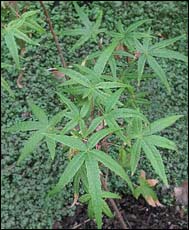 I saw a newly planted maple tree in the greenhouse where the Camellia japonicas bloom in the winter. It was an odd thing to find there: why plant a maple that will soon loose its leaves among all these pampered evergreen exotics? The maple growing here is just a sapling, no more than three-feet tall with a trunk about an inch across. A nearby sign identified it as an Acer pentaphyllum. China was listed as its native habitat. Each of the tree’s leaves has five distinct saw-toothed leaflets that join at a salmon-colored stem – something I’d never seen before. Flora, my two-volume set of all things horticultural, says that “this striking and elegant small tree [25 – 30 feet tall] is believed to be extinct in the wild.” Even in cultivation it’s very uncommon. Flora says that Acer pentaphyllum needs a climate in zone 7, 8, or 9 to thrive. Such tenderness explains why it’s here and not outside in the zone 6 climate of this botanical garden. I saw a newly planted maple tree in the greenhouse where the Camellia japonicas bloom in the winter. It was an odd thing to find there: why plant a maple that will soon loose its leaves among all these pampered evergreen exotics? The maple growing here is just a sapling, no more than three-feet tall with a trunk about an inch across. A nearby sign identified it as an Acer pentaphyllum. China was listed as its native habitat. Each of the tree’s leaves has five distinct saw-toothed leaflets that join at a salmon-colored stem – something I’d never seen before. Flora, my two-volume set of all things horticultural, says that “this striking and elegant small tree [25 – 30 feet tall] is believed to be extinct in the wild.” Even in cultivation it’s very uncommon. Flora says that Acer pentaphyllum needs a climate in zone 7, 8, or 9 to thrive. Such tenderness explains why it’s here and not outside in the zone 6 climate of this botanical garden.I came across a fascinating article about this unusual maple tree written by William A. McNamara, director of QuaryHill Botanical Garden in California’s Sonoma Valley. McNamara is a modern-day plant hunter. For more than a decade he travelled to China to try to find a wild stand of Acer pentaphylum. Finally in 2001 with the help of Chinese botanist Yin Kaipu, he saw a 33-foot tall specimen of this rare maple tree. McNamara wrote “The tree had obviously been cut several times, apparently for fuel, giving it a dense shrubby appearance.” Looking around he saw six more trees in the distance. Dr. Yin told him that these trees were the last known stand of Acer pentaphyllum in the wild. With increasing demands for wood to fuel village fires, McNamara wrote, “It was hard to imagine these few rare trees surviving another twenty years.” 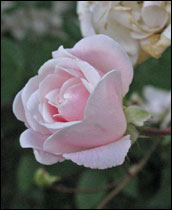 A rose without thorns filled with small flowers and tiny buds. Include a light sweet scent and papery shades of pink and white in the package. I don’t how I could have overlooked this shrub of a polyantha rose named ‘Marie Pavie.’ This week it’s in full bloom in the Scented Garden. ‘Marie Pavie’ took no notice of the cold – not even a touch of freezer burn. A rose without thorns filled with small flowers and tiny buds. Include a light sweet scent and papery shades of pink and white in the package. I don’t how I could have overlooked this shrub of a polyantha rose named ‘Marie Pavie.’ This week it’s in full bloom in the Scented Garden. ‘Marie Pavie’ took no notice of the cold – not even a touch of freezer burn.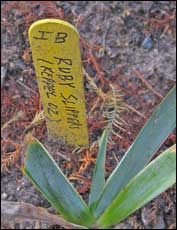 One of the beds in the iris garden has been renewed again. Like a highway through a city, the iris garden in this botanical garden seems to be constantly under construction. This time a thematic bed has been added. All of the several dozen small starts in the new bed are named for storied characters that kids might know about. I had no trouble identifying characters from comic books, fairy tales, movies, or tv (Spiderman, Cinderella, Tweety Bird, Blues Clues, Sneezey, Auntie Em). For irises based on children’s books I needed help. My wife (who knows about such things) explained that Goodnight Moon is a book about a bunny (she couldn’t remember its name) who has to say goodnight to all the things in his bedroom before going to sleep. Dumbledore, she said, was the wizard in the Harry Potter books and Pippi Longstocking was a little girl with red pigtails who bested most of the adults she met. One of the beds in the iris garden has been renewed again. Like a highway through a city, the iris garden in this botanical garden seems to be constantly under construction. This time a thematic bed has been added. All of the several dozen small starts in the new bed are named for storied characters that kids might know about. I had no trouble identifying characters from comic books, fairy tales, movies, or tv (Spiderman, Cinderella, Tweety Bird, Blues Clues, Sneezey, Auntie Em). For irises based on children’s books I needed help. My wife (who knows about such things) explained that Goodnight Moon is a book about a bunny (she couldn’t remember its name) who has to say goodnight to all the things in his bedroom before going to sleep. Dumbledore, she said, was the wizard in the Harry Potter books and Pippi Longstocking was a little girl with red pigtails who bested most of the adults she met.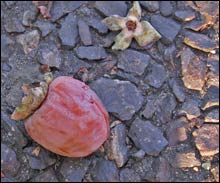 The native persimmon trees (Diospyros virginiana) in the botanical garden are loaded with fruit this year. Many have already fallen. Most of the squishy fruits split open from their tree fall. Lots more have been stepped on by visitors to the garden. There’s something about the elegant shape of a ripened persimmon makes me stop to look and then take a picture. A century old book on native trees picked up from a library book sale links persimmon trees with opossums. The writer says that because opossums were often seen in trees eating persimmons, the tree and the animal were woven into fables and folk tales. Here’s one about why the possums have no hair on their tails. The native persimmon trees (Diospyros virginiana) in the botanical garden are loaded with fruit this year. Many have already fallen. Most of the squishy fruits split open from their tree fall. Lots more have been stepped on by visitors to the garden. There’s something about the elegant shape of a ripened persimmon makes me stop to look and then take a picture. A century old book on native trees picked up from a library book sale links persimmon trees with opossums. The writer says that because opossums were often seen in trees eating persimmons, the tree and the animal were woven into fables and folk tales. Here’s one about why the possums have no hair on their tails. |
||||||||||||||||||||||||||||||||||||||||||